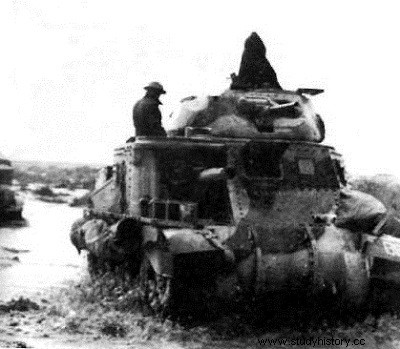
The operation was to begin on November 29, according to a very attractive plan on the map, but which was pathetically unrealistic in the facts. Djedeida was the target of a battalion from the Northampton regiment, reinforced with a battery of 25-pounder shells and Grant medium tanks from battle group B of the division
American armored vehicle. The second parachute battalion, under the command of the dreaded Lieutenant-Colonel John D. Frost, was to be dropped by 44 Dakotas on Depienne airport (unoccupied in reality, it was a simple emergency runway) far inside from the Axis lines.
The aim was to reduce the dive bombing potential of the Luftwaffe which, little by little, was wearing down the British forces. After taking the base at Djedeida, British and American armor would push on Tunis to complete the success. Djedeida was attacked twice, but without success. The Northamptons were blasted with lethal Spandau machine-gun fire, and the remaining German anti-tank guns wreaked havoc among the Grant tanks of Battle Group B which had ventured into flat open ground. The Chouigui phase and to penetrate deeply into the positions of the 11th brigade through the Tebourba gap.
It was not the lack of will that prevented Fischer from annihilating the 11th brigade, but the formidable resistance from the British and Americans, and particularly the survivors of the Hampshires and East Surreys and the 25-pounder batteries of the Royal Artillery.
On December 1, the 11th Brigade was attacked in front, in its center, and in its rear Major Luder's battle group coming out from the north threatened to overwhelm the brigade's headquarters, fortunately located close to the 25-pounder guns of the 321st Field Battery and the mountain howitzers. 3.7-inch (95 mm) guns of the 457th Light Battery. An avalanche of shells knocked out six German tanks and Luder had to fall back.
The next day, December 2, the 13th Regiment armored vehicle recalled from Medjez-el-Bab attacked Luder in turn and held him in check, not without suffering on this occasion heavy losses in tanks. Hudel, also attacking from the north, drove the Northamptons from their positions. But the East Surreys managed to repel Koch's assault at El-Bathan. The heaviest fighting took place in front of Tebourba, where the Hampshires succeeded in containing the "Djedeida" battle group for three days.
Their leader, Lieutenant-Colonel William C. Lee did not like the all the position that had been assigned to him. He had requested permission either to attack Djedeida on his own, and hold on there, or to fall back to form a continuous front with East Surrey. Both replies were negative, and the battalion remained isolated in its position, determined to defend it to the end, but without hope.
“Djedeida” made a first infantry attack on the 1st December. It was repulsed. The Hampshires then showed themselves to be extremely aggressive, each beginning of a breach in their arrangements being immediately plugged by a relentless counter-attack.
The next day the affair became more The enemy had received tanks as reinforcements, and this was the beginning of a series of fantastic hand-to-hand combat. The fighting took place in a valley floor covered with olive trees and the gunners often only saw their objectives. 'at the last second. For a moment the German tanks succeeded in penetrating inside the defensive perimeter, and were preparing to execute a platoon at the distance of 20 meters, when Captain Thomas, who commanded the company realized that the most serious threat comes from is born from the accompanying infantry and not from the tanks.
